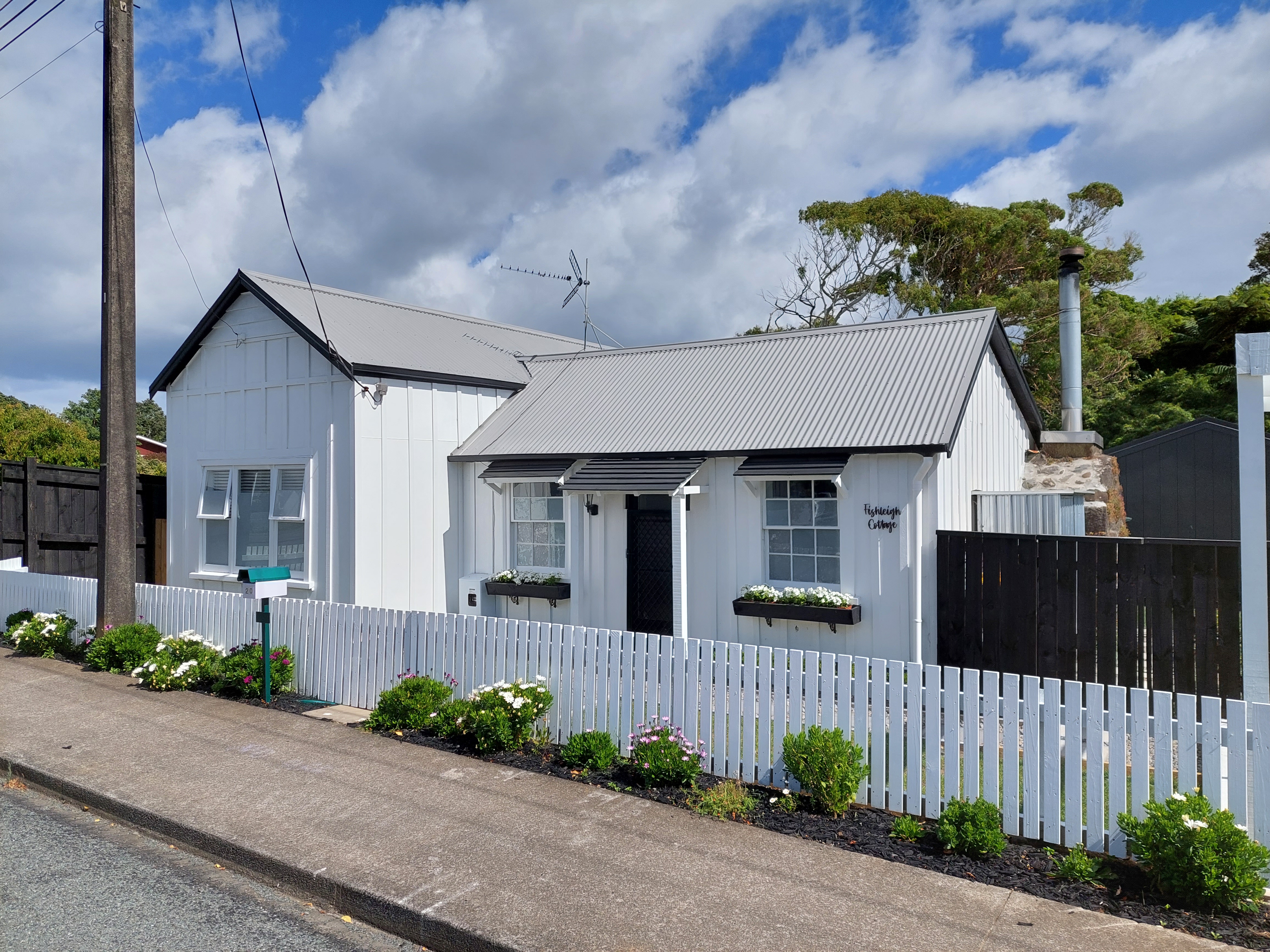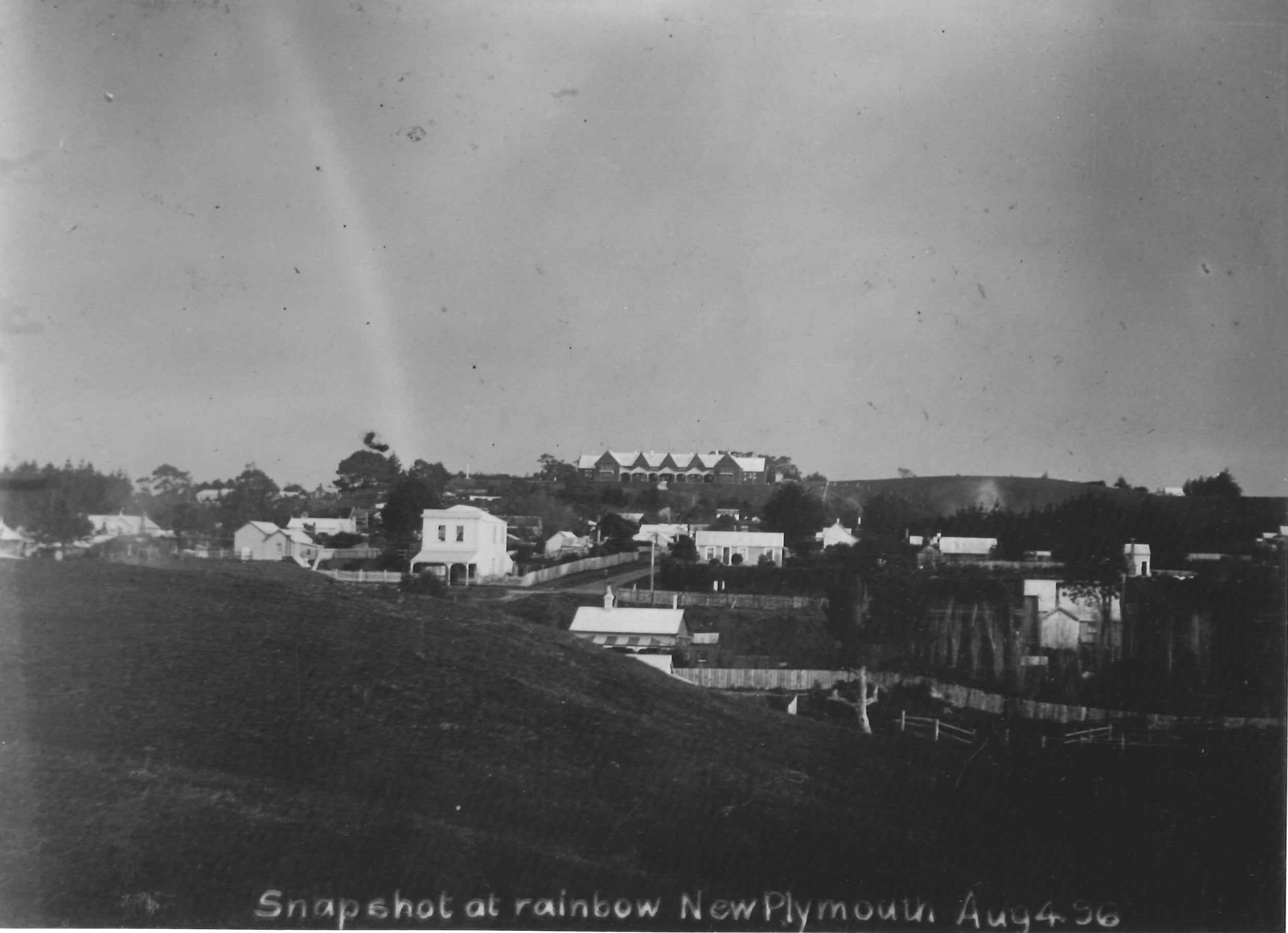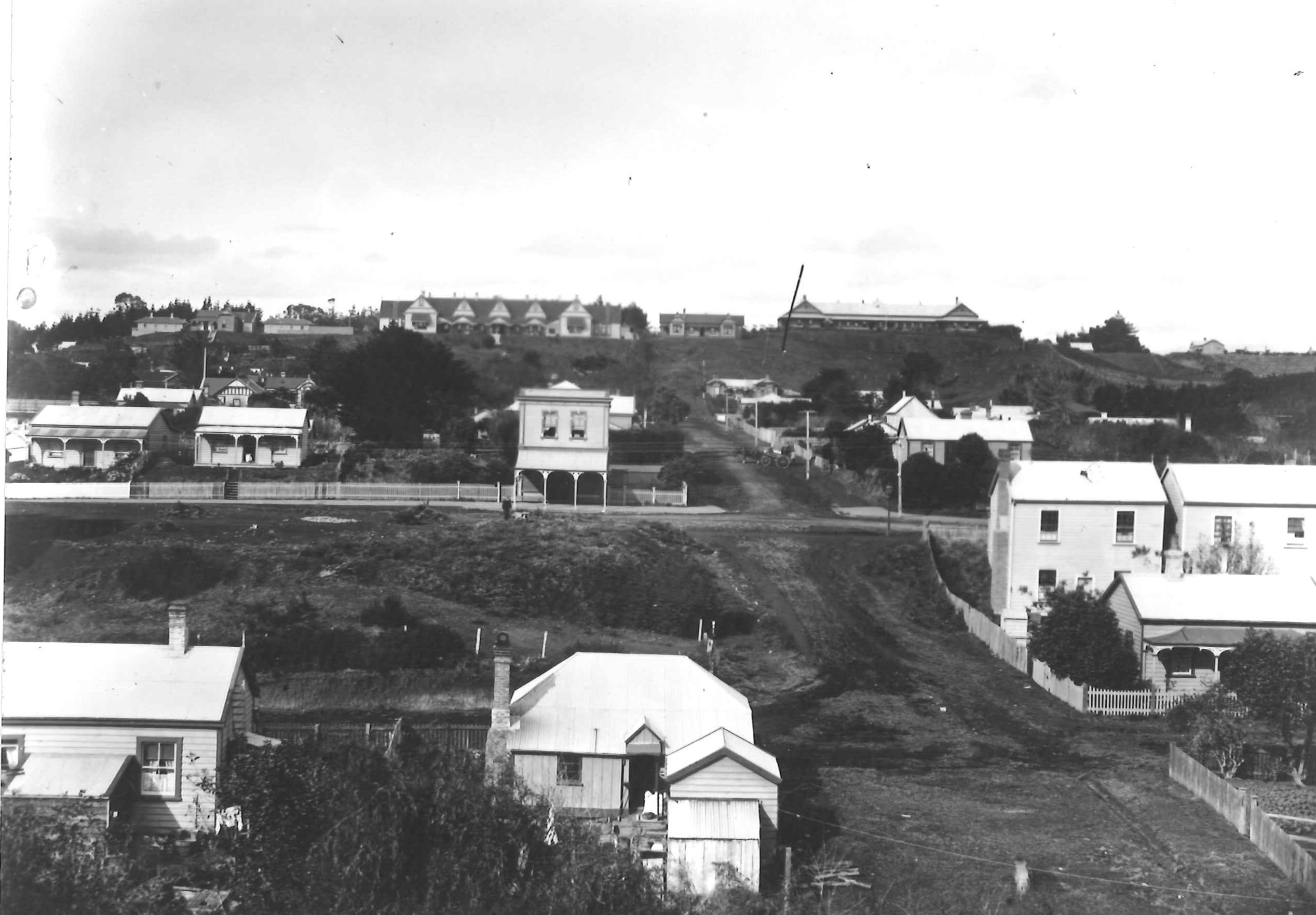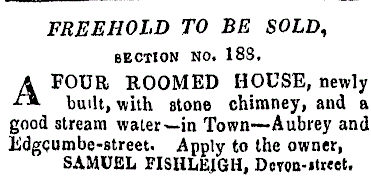





Town Section 188 was one of the original New Plymouth Town Sections laid out by surveyor Frederick Alonzo Carrington in 1841. A list of town section allocations dated 3 September 1842 notes that the section was originally allocated to “Company” (Plymouth Company). Later, the property seems to have been purchased by William Wheeler, who is noted as the owner on an undated (circa mid-1850s) New Zealand Company rating roll held by Puke Ariki; at this time the property was valued at £10.
At some stage prior to late 1855, the vacant section was purchased by early settler Samuel Fishleigh, who is listed as being in arrears for rates on the section in November 1855. It seems likely the property was sold to Fishleigh to cover unpaid rates by Wheeler, who is still listed as owing rates on Town Section 188 up until 1858.The official Crown Grant for Section 188 was issued to Samuel Fishleigh on 1 November 1857. (Taranaki Land Deed Index I1 page 347)
As was the case with Town Section 188, delays in Crown Grants often meant that sections were occupied by owners before they were officially granted by the Crown. An advertisement was placed in the Taranaki Herald on 14 February 1857, advertising a four-roomed house on Town Section 188, newly built, with stone chimney, and good stream water, for sale by owner Samuel Fishleigh. This dates the original portion of the cottage to late 1856 or early 1857, making it one of the oldest surviving buildings in New Plymouth. Samuel Fishleigh is the presumed builder and is listed as a ‘shingler’ in the 1856 New Plymouth census. The cottage did not sell in 1857 and appears to have been rented for the remainder of Fishleigh’s ownership. In April 1858, the cottage was advertised for let, currently in the occupation of Mr Coade, a brewer.

Taranaki Herald, 14 February, 1857
Fishleigh Cottage is significant for having survived the turbulent Taranaki Wars of the 1860s; despite being located outside the inner defensive line that surrounded central New Plymouth. Many buildings located outside of the inner town defences were destroyed during the conflict; including Fishleigh’s own home on Frankley Road. It is speculated that Fishleigh Cottage may have survived because of its proximity to Fort Murray, one of nine blockhouses erected around New Plymouth in the winter of 1860. Fort Murray was located on the high ground overlooking the cottage (present-day Duke Place), on the site of the pre-European Rungapiko pā.
References to Fishleigh Cottage are infrequent during the next two decades, although in 1869, Samuel Fishleigh complained of the 'overgrowth of furze [gorse] fences' blocking the roads, 'bounding his property in Aubrey and Edgecumbe Streets'. In August 1872, Samuel Fishleigh also complained about the bad state of Aubrey Street near his property, stating that the bakers refuse to take bread to it. The cottage remained in Samuel’s ownership until his death in 1873, when the property passed to his wife Hannah Fishleigh. The New Plymouth Town Board rating book for 1875-76 shows brewer John Hamblyn (who was then renting the cottage) took over responsibility for paying the rates in 1876, with the property having a rateable value of £20 at this time.
Hannah Fishleigh remained the owner of the property until 1882, when a property title was issued to John Hamblyn under the Land Transfer Act. Little is known about John Hamblyn, although like earlier tenants of the cottage, he was a brewer by trade; he married widow Ann Francis during December 1884. John Hamblyn was declared bankrupt during March 1885, although was discharged a year later, in March 1886, on account of his ill health. John passed away during December 1886 and it seems Ann was unable to meet the mortgage repayments, with the property sold by the mortgagee under a power of sale clause soon after.
The purchaser of the house was Alfred Francis of Auckland, one of Ann’s sons from her first marriage to Samuel Francis. New Plymouth Borough Council rates books from 1887-88 onwards note Alfred Francis as being responsible for paying the rates, although he didn’t reside in the house himself, street directories revealing it continued to be occupied by Ann, along with two of her other sons, horse trainer Charles Francis, and carpenter Edwin Francis. Ann Hamblyn later moved to Auckland and passed away at the residence of her daughter during 1901, with Charles Francis probably moving out of the house soon after.
Edwin Francis remained living in the house with his wife Miss Margaret Moore (whom he married during 1898), and children, Aubrey Edwin (b.1899 – died aged 10 weeks) and Mary Viola Ellen (b.1901). Edwin Francis is the presumed builder for the western north-south gable addition, which was completed sometime between mid-1896 and early-1902, with the addition not present in a photograph dated August 4, 1896, and no permit being recorded for its construction in the New Plymouth Borough Council (NPBC) permit books; the NPBC recorded permits, for which one would almost certainly have been issued for this work, from 1 April 1902. It is possible the gable addition was constructed around the time of the Francis’ marriage in 1898, or around the time of the birth of one of their children.
Tragically, Margaret Francis passed away during 1909 aged just 38 years, although Edwin and Mary continued to reside in the house. Alfred Francis retained ownership of the property until his death in late-1922, after which time ownership was transmitted to his brothers George and Edwin Francis, who were appointed to manage Alfred’s intestate estate.During early-1924, Edwin Francis became the sole owner of the property. Edwin’s daughter Mary, or Ella as she was known, married George Herbert Tanswell during 1926 and the couple appears to have moved to George’s homeland of Australia. Mary seems to have become ill and later returned to New Zealand, residing at her father’s house in Aubrey Street until her death in August 1933.
Sometime during the early 1940s, Peter Tanswell, later described as Edwin’s grandson, and possibly the son of Mary’s husband George from his first marriage, moved into the cottage with Edwin. Peter saw active service in the Second World War before returning to New Plymouth where he again resided at the Aubrey Street cottage. Edwin remained living at 20 Aubrey Street until his death in September 1948, after which time the property was transmitted to the Public Trustee.
In early 1949, ownership of the property was transferred to Peter Tanswell, who in March of that year, commissioned builder Mr Harold W. Rowe to make alterations and additions valued at £300 to the cottage. These included:
At some stage between 1949 and the early 1960s, further alterations were made to the cottage, although no record of these can be found. These included the:
Peter continued living at the cottage until 1955, when the property was sold to retiree John Augustus Atkins. Atkins only resided at the cottage until late-1961, when the property was purchased by manager Myrtle May Emett, husband of Robert Roy Emett. The Emett’s lived in Young Street and from the time of their purchase they rented out the cottage to public servant Stanley (Stan) Mack Robinson and his wife Mary Cecilia Robinson, who resided in the cottage with Paul Cotter, Mary’s son from her first marriage; the Robinson’s are first listed at 20 Aubrey Street in the 1962 Taranaki Telephone Book, and are first recorded as residing at the property in the 1963 Electoral Roll. Owner Myrtle Emett passed away in 1971 and the property was transmitted to the Public Trustee, before being purchased by Stan Robinson in 1973.
It was during the Robinson’s occupation that a number of exterior and interior alterations were made to the cottage. Many of these alterations were carried out during the 1960s and 1970s, although no record of this work survives in either the NPDC Archives or the Building Permit Registers held by Puke Ariki. Exterior work undertaken included:
Interior work undertaken included:
Stan and Mary remained living in the house for the rest of their lives, Stan until his death during 2011, aged 91 years, and Mary until her death in 2017, aged 92 years. Following Mary’s death, ownership of the property passed to Paul Cotter, before being sold in late 2017; the property was first transferred to Up Developments Ltd, and then on to Christopher Bruce Simkin and C B Simkin Trustee Company Limited in 2018. Two new houses were constructed at the rear of the original cottage during 2019, and the detached single car garage located on the eastern side of the cottage, and a workshop located on the western side of the cottage, were demolished; the property was subdivided into three allotments during late 2019.
Fishleigh Cottage was subsequently sold on a smaller allotment and restored during 2020-21.
Please do not reproduce these images without permission from Puke Ariki.
Contact us for more information or you can order images online here.